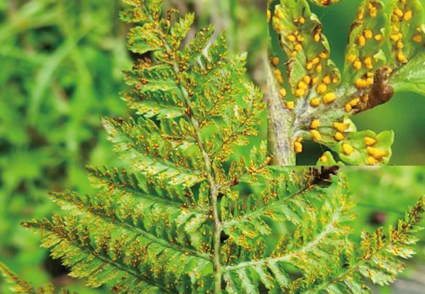Abstract
Three rust fungi belonging to the genus Hyalopsora occurring on ferns were found in China. Hyalopsora minispora and H. tibetica are described as new species in this paper. Hyalopsora minispora can be distinguished from known species by its relatively small urediniospores (19.5–23.0 × 12.0–19.0 μm) with 4–6 scattered germ pores and amphispores in a common pustule. Hyalopsora tibetica is mainly characterized by urediniospores with 2–6 scattered germ pores and amphispores. Hyalopsora neocheilanthis is described and reported as a new record for China. The phylogenetic relationships of Hyalopsora species and related taxa were examined by comparing the sequences of their internal transcribed spacer 2 (ITS2) barcode and 28S rDNA gene segments. Hyalopsora is supported with strong bootstrap support and it differs from the two other fern-infecting genera viz. Milesina and Uredinopsis.
References
Aime, M.C. & McTaggart, A. (2020) A higher-rank classification for rust fungi, with notes on genera. Fungal Systematics and Evolution 7: 21–47. https://doi.org/10.3114/fuse.2021.07.02
Arthur, J.C. (1906) New species of Uredineae-IV. Bulletin of the Torrey Botanical Club 33 (1): 27–34. https://doi.org/10.2307/2478619
Arthur, J.C. (1924) Fern rusts and their aecia. Mycologia 16 (5): 245–251. https://doi.org/10.1080/00275514.1924.12020444
Azbukina, Z.M. (2015) Definitorium fungorum Rossiae, Ordo Pucciniales 1. Dalnauka, Vladivostok. [In Russina]
Berndt, R. (2008) The rust fungi (Uredinales) on ferns in South Africa. Mycological Progress 7 (1): 7–19. https://doi.org/10.1007/s11557-007-0548-7
Bubner, B., Buchheit, R., Friderich, F., Kummer, V. & Scholler, M. (2019) Species identification of European forest pathogens of the genus Milesina (Pucciniales) using urediniospore morphology and molecular barcoding including M. woodwardiana sp. nov. MycoKeys 48: 1–40. https://doi.org/10.3897/mycokeys.48.30350
Cao, Z.M. & Li, Z.Q. (1999) Rust fungi of Qinling Mountains. China Forestry Publishing House, Beijing. [In Chinese]
Chen, M.M. (1982) New species and new record of fungi in the China-Himalaya flora. Acta Phytopathologica Sinica 12 (01): 27–32. [In Chinese] https://doi.org/10.13926/j.cnki.apps.1982.01.006
Chen, M.M. (1989) The rust flora of Sino-Himalayan forests. Canadian Journal of Botany 67 (3): 827–833. https://doi.org/10.1139/b89-111
Cummins, G.B. & Hiratsuka, Y. (1983) Illustrated genera of rust fungi. Revised ed. St. Paul, Minnesota: APS Press.
Cummins, G.B. & Hiratsuka, Y. (2003) Illustrated genera of rust fungi, 3rd edn. The American Phytopathological Society Press, St. Paul.
Gardes, M. & Bruns, T.D. (1993) ITS primers with enhanced specificity for basidiomycetes-application to the identification of mycorrhizae and rusts. Molecular Ecology 2 (2): 113–118. https://doi.org/10.1111/j.1365-294x.1993.tb00005.x
Hillis, D.M. & Bull, J.J. (1993) An empirical test of bootstrapping as a method for assessing confidence in phylogenetic analysis. Systematic Biology 42: 182–192. https://doi.org/10.1093/sysbio/42.2.182
Hiratsuka, N. (1936) A monograph of the Pucciniastreae. Memoris of the Tottori Agricultural College 4: 1–374.
Hiratsuka, N. (1958) Revision of taxonomy of the Pucciniastreae with special reference to species of the Japanese Archipelago. Kasai Publishing and Printing, Tokyo.
Hiratsuka, N. & Chen, Z.C. (1991) A list of Uredinales collected from Taiwan. Transactions of the Mycological Society of Japan 32: 3–22.
Hiratsuka, N., Sato, S., Katsuya, K., Kakishima, M., Hiratsuka, Y., Kaneko, S., Ono, Y., Sato, T., Harada, Y., Hiratsuka, T. & Nakayama, K. (1992) The rust flora of Japan. Tsukuba: Tsukuba Shuppankai.
Ji, J.X., Li, Z., Li, Y., Zhuang, J.Y. & Kakishima, M. (2018) Notes on rust fungi in China 4. Hosts and distribution of Hyalopsora aspidiotus and H. hakodatensis. Mycotaxon 133 (1): 23–29. https://doi.org/10.5248/133.23
Kirschner, R., Lee, P.H. & Huang, Y.M. (2019) Diversity of fungi on Taiwanese fern plants: review and new discoveries. Taiwania 64 (2): 163–175. https://doi.org/10.6165/tai.2019.64.163
Katoh, K. & Toh, H. (2010) Parallelization of the MAFFT multiple sequence alignment program. Bioinformatics 26 (15): 1899–1900. https://doi.org/10.1093/bioinformatics/btq224
Kumar, S., Stecher, G. & Tamura, K. (2016) MEGA7: Molecular Evolutionary Genetics Analysis version 7.0 for bigger datasets. Molecular Biology and Evolution 33: 1870–1874. https://doi.org/10.1093/molbev/msw054
Kuprevich, V. & Transhel, V. (1957) Cryptogamic Plants of the USSR, Vol. IV, Rust Fungi. No. 1, Family Melampsoraceae. U.S.S.R. Academy sciences.
Larget, B. & Simon, D.L. (1999) Markov chain Monte Carlo algorithms for the Bayesian analysis of phylogenetic trees. Molecular Biology and Evolution 16 (6): 750–759. https://doi.org/10.1093/oxfordjournals.molbev.a026160
McTaggart, A.R., Geering, A.D.W. & Shivas, R.G. (2014) Uredinopsis pteridis and Desmella aneimiae, the first rust fungi (Pucciniales) reported on ferns (Pteridophyta) in Australia. Australasian Plant Disease Notes 9: 149. https://doi.org/10.1007/s13314-014-0149-7
Ono, Y. (2017) Rust fungi (Pucciniales) in northern Ibaraki Prefecture, Japan. Journal of General Plant Pathology 66: 37–56.
Posada, D. & Crandall, K.A. (1998) Modeltest: testing the model of DNA substitution. Bioinformatics 14: 817–818. http://doi.org/10.1093/bioinformatics/14.9.817
Ronquist, F. & Huelsenbeck, J.P. (2003) MRBAYES 3: Bayesian phylogenetic inference under mixed models. Bioinformatics 19: 1572–1574. http://doi.org/10.1093/bioinformatics/btg180
Royal Botanic Gardens Kew (2021) Mycology Section, Landcare Research-NZ, Mycology Group, Institute of Microbiology & Chinese Academy of Science. Available from: www.indexfungorum.org/ (accessed 22 March 2021)
Saba, M., Khalid, A.N. & Berndt, R. (2012) Hyalopsora nodispora is the new holomorph name for Uredo capilli-veneris (Uredinales, Pucciniastraceae) from Pakistan. Mycological Progress 11 (4): 967–969. https://doi.org/10.1007/s11557-012-0828-8
Sydow, P. & Sydow, H. (1914) Monographia uredinearum seu specierum omnium ad hunc usque diem cognitarum descriptio et adumbratio systematica. Science 39: 651–654. https://doi.org/10.1126/science.39.1009.651
Swofford, D.L. (2002) PAUP*: phylogenetic analysis using parsimony *and other methods, Version 4.0b10. Sinauer Associates, Sunderland.
Tian, C.M., Shang, Y.Z., Zhuang, J.Y., Wang, Q. & Kakishima, M. (2004) Morphological and molecular phylogenetic analysis of Melampsora species on poplars in China. Mycoscience 45 (1): 56–66. https://doi.org/10.1007/S10267-003-0150-Z
Vogler, D.R. & Bruns, T.D. (1998) Phylogenetic relationships among the pine stem rust fungi (Cronartium and Peridermium spp.). Mycologia 90 (2): 244–257. https://doi.org/10.1080/00275514.1998.12026904
Wang, Y.Z., Han, S.J., Wei, S.X., Guo, L. & Chen, M.M. (1980) New rust fungi from western China. Acta Microbiologica Sinica 20 (1): 16–28.
Xue, Y., Li, Z.Y., Zhang, M. & Xiao, X.Y. (1997) A new record species of Hyalopsora in China. Bulletin of Chinese Botanical Research 17: 54–55.
Yang, T., Tian, C.M., Liang, Y.M. & Kakishima, M. (2014) Thekopsora ostryae (Pucciniastraceae, Pucciniales), a new species from Gansu, northwestern China. Mycoscience 55 (4): 246–251. https://doi.org/10.1016/j.myc.2013.09.005
Yang, T., Tian, C.M., Lu, H.Y., Liang, Y.M. & Kakishima, M. (2015) Two new rust fungi of Thekopsora on Cornus (Cornaceae) from western China. Mycoscience 56 (5): 461–469. https://doi.org/10.1016/j.myc.2015.02.001
Zhuang, J.Y. (1983) A provisional list of Uredinales of Fujian Province, China. Acta Mycologica Sinica 2: 146–158.


